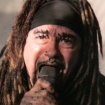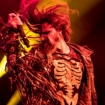In late 1990, Spin magazine hired photographer Paul Elledge to shoot industrial-metal pioneers Ministry, who were on the road supporting their fourth full-length, The Mind Is a Terrible Thing to Taste, in his Chicago studio—and things didn't start auspiciously. "The band blew me off the first time, so the second time I was a little surly with them," he recalls. "But then they got to my studio and saw some of my gallery work, which at the time was very much in the spirit of what I would eventually do for the Psalm 69 cover."
Elledge and Ministry main man Al Jourgensen ended up hitting it off and, after staying up all night partying together, Jourgensen enlisted the artist to shoot a video for the band's 1991 single, "Jesus Built My Hotrod." Jourgensen also drafted Elledge to shoot the engine photograph on the single's sleeve, as well as create the cover for their 1992 album, Psalm 69: The Way to Succeed and the Way to Suck Eggs.

As inspiration for the latter's artwork, Jourgensen gave Elledge tapes of the music that would end up on the record and a copy of Aleister Crowley's 1913 tome, The Book of Lies, chapter 69 of which had inspired the title of the album. (Both the chapter and album are references to the "69" sex position, or as Crowley describes it, "the way to suck seed and the way to suck eggs.") Elledge drew from this material, as well as from his conversations with Jourgensen: "The border icons [on Psalm 69]—the clocks, the razorblade, the dice, the coins, and the plane were little clues to what I heard in the music or to what I'd talked with Al about."
The final cover image is a triple exposure—three images on one piece of film. For the first, Elledge shot a model from Chicago's Art Institute, who was wearing angel wings crafted by the artist's wife at the time. The second was the border icons; he poured sand on the edges to soften them. Finally, the third exposure was for texture, "to fuck it up a little bit," as Elledge says. "I'd use Brillo pads and tacks to do that. It was kind of an interesting procedure: If you screw it up, you're done, because it's on the actual negative."
Elledge—who would go on to create many more album covers and videos for Ministry—estimates that the entire process, from initial photography to final layout, took about a week of intensive work. "I was very into doing painful things in the late '80s and early '90s," he says with a laugh. "A lot of people look at that cover now and think it's digitally composed, but it's completely old-fashioned."
"Ministry's music is very layered, very stepped-on, I guess you could say, with guitars and samples," the photographer continues. "And the process for the Psalm 69 cover kind of resonates from a similar spot."




